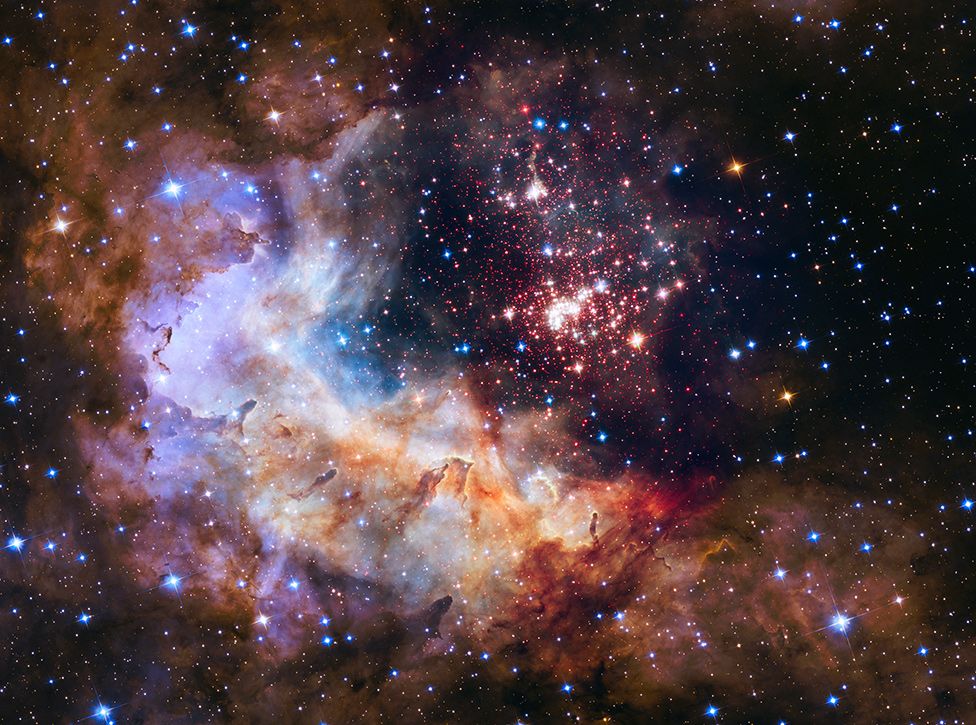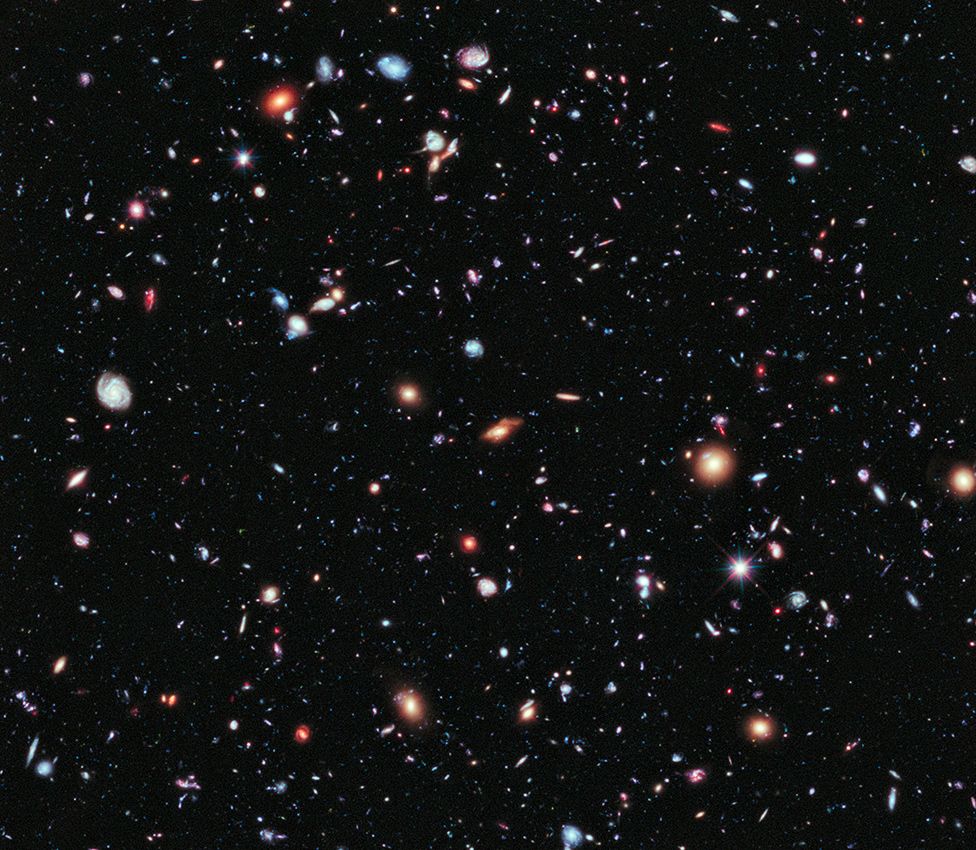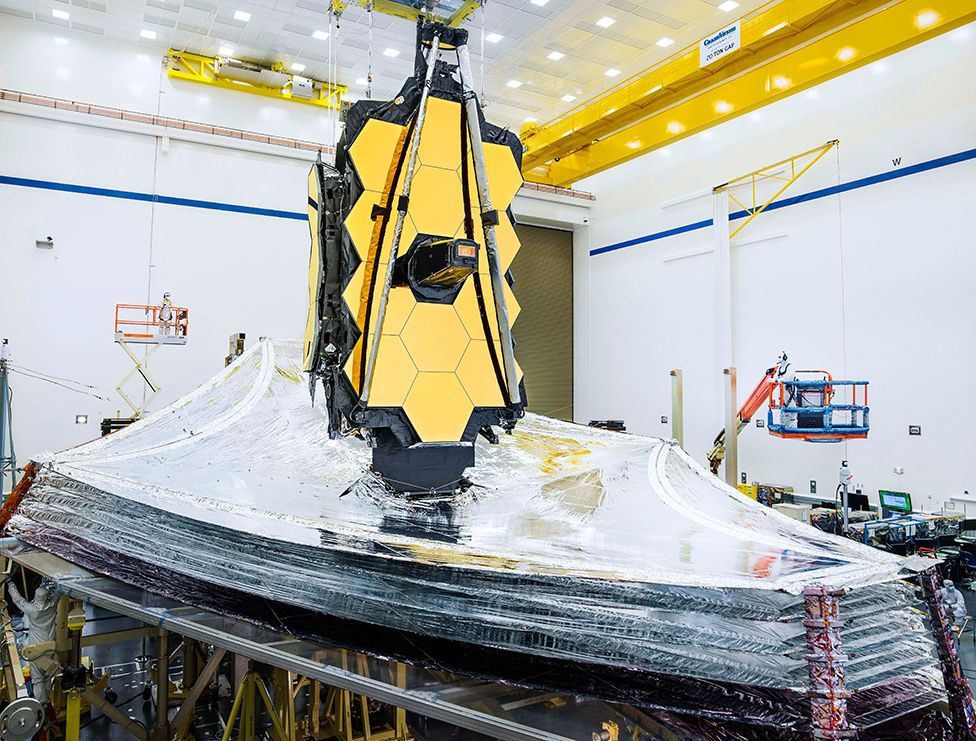
It's 30 years ago to the day that the Hubble telescope was launched - and to celebrate its birthday, the veteran observatory has produced another astonishing image of the cosmos.
This one is of a star-forming region close to our Milky Way Galaxy, about 163,000 light-years from Earth.
The larger object is the nebula NGC 2014; its companion is called NGC 2020.
But astronomers have nicknamed the scene the "Cosmic Reef" because it resembles an undersea world.
Famously blighted by blurred vision at the outset of its mission in 1990, Hubble was eventually repaired and upgraded.
The remarkable pictures it has taken of planets, stars, and galaxies have transformed our view of the cosmos.
Indeed, there are those who think Hubble is the most important scientific tool ever built.
It's still far from retirement.
The US space agency (Nasa), which runs the observatory in partnership with the European Space Agency (Esa), says operations will be funded for as long as they remain productive.
Last year, its data resulted in almost 1,000 scientific papers being published - so it continues to stand at the forefront of discovery.
The BBC is broadcasting a special programme called: Hubble: The Wonders of Space Revealed. It goes out at 2100 BST on BBC Two. It contains some fascinating visualisations. Read about how they were made here.

Image copyrightNASA/ESA Image captionFor its 25th birthday, Hubble imaged a giant cluster of stars called Westerlund 2
Engineers obviously keep a watching brief on the health of Hubble's various systems. Pleasingly, all four instruments onboard - the two imagers and two spectrographs - work at full tilt.
In the past, the telescope's Achilles heel has been the six gyroscopes that help turn and point the facility, maintaining a rock-steady gaze at targets on the sky.
These devices have periodically failed down the years, and during their final servicing mission in 2009 space shuttle astronauts were tasked with replacing all six.
Three have subsequently shut down again, but Nasa project scientist Dr Jennifer Wiseman says this is not yet an issue for serious concern.
"Nominally, we need three gyroscopes, but we can operate on just one due to the ingenuity of the engineers," she asserted.
There's a quiet confidence that Hubble can keep working well into the 2020s. Its supposed "successor" - the James Webb Space Telescope (JWST) - is due for launch next year, but the presence in orbit of this more modern observatory will in truth merely just extend capability; it won't make Hubble redundant.
That's because the new facility has been designed to see the cosmos at longer wavelengths of light than Hubble. The duo will be complementary and will on occasion actually pursue targets together to get a fuller perspective.
This is an exciting prospect for astronomers everywhere - but especially for those in Europe where Hubble has been such a rewarding endeavour, says Esa project scientist Dr Antonella Nota.
"From the memorandum of understanding there was a guarantee that European astronomers would get 15% of observing time for the duration of the mission. If I look back at how much time European astronomers got - on average it's 22%. And it is a peer-reviewed process so we never needed to put a finger on the scales. European astronomers are creative; they're smart; they're doing leading-edge science," she told BBC News.
What has Hubble contributed to science?
It's a bit of a cliche, but Hubble has truly been a "discovery machine".
Before the telescope launched in 1990, astronomers didn't know whether the Universe was 10 billion years old or 20 billion years old.
Hubble's survey of pulsating stars narrowed the uncertainty, and we now know the age extremely well, at 13.8 billion.
The observatory played a central role in revealing the accelerating expansion of the cosmos - a Nobel Prize-winning breakthrough - and it provided the definitive evidence for the existence of super-massive black holes at the centre of galaxies
Image copyrightNASA/ESAImage captionThe Deep Field images require Hubble to stare at the
It's amazing to think that when Hubble launched, scientists had yet to detect the first exoplanet, the name given to a planet orbiting a star other than our Sun. Today, Hubble is pioneering the study of these far-off worlds, examining their atmospheres to try to gauge their nature.
And although the sparkling eight-metre-class ground-based telescopes can now match - and even exceed - Hubble's skill in certain fields of study, the space telescope remains peerless in going super-deep.
Its so-called Deep Field observations in which it stared at a small patch of sky for days on end to identify the existence of very distant, extremely faint galaxies is one of the towering achievements in astronomy.
These studies have shown us what the Universe was like just a few hundred million years after the Big Bang. Only JWST, with its finely-tuned infrared detectors, will go deeper still.
Image copyrightNASA/ESAImage captionA Hubble classic: The Veil Nebula is the expanding debris
Kathryn Sullivan was one of the astronauts onboard Space Shuttle Discovery when it released Hubble into its 612km-high orbit on 25 April, 1990 - a day she recounts in a recent book, Handprints On Hubble.
"Hubble's scientific impact has just been immense. But what I had not really appreciated until I started writing my book was the extent to which Hubble - because of its gorgeous images and their mind-bending implications - has really permeated popular culture," she told BBC News.
"I see Hubble on the side of U-Haul (rental) trailers, on tattoos, on lunchboxes, on shirts, in advertisements, almost ubiquitously.
"And I think part of that is down to Hubble coming into service just as the internet was becoming the thing we now know it to be.
"That's put the pictures right in front of people."
Image copyrightNASAImage captionJWST will study the Universe at longer wavelengths of light




 Previous page
Previous page Back to top
Back to top







